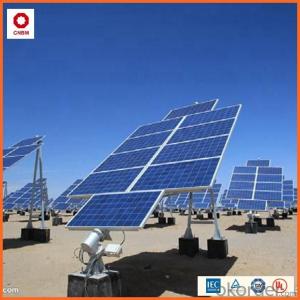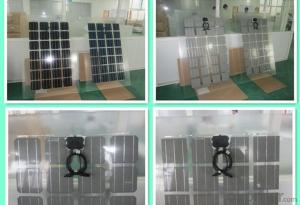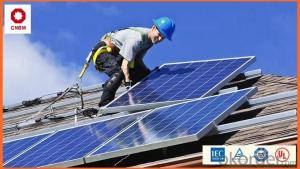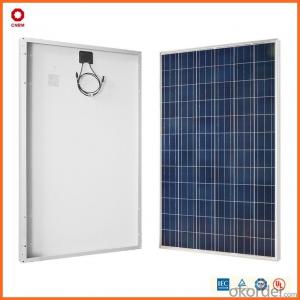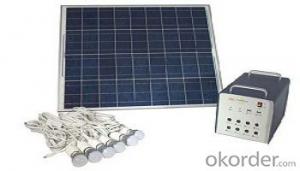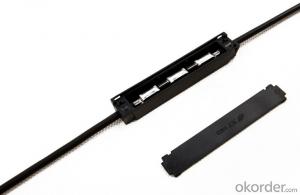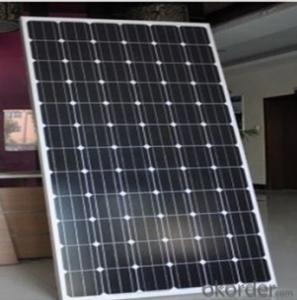70w Small Solar Panels in Stock China Manufacturer
- Loading Port:
- China main port
- Payment Terms:
- TT OR LC
- Min Order Qty:
- 1 watt
- Supply Capability:
- 10000000 watt/month
OKorder Service Pledge
OKorder Financial Service
You Might Also Like
Item specifice
Product Description:
Hot Sale !!! Quality and Safety of Small Poly Solar Panel 5w~150w
1. Rigorous quality control meets the highest international standards.
2. High-transmissivity low-iron tempered glass, strong aluminium frame.
3. Using UV-resistant silicon.
4. IS09001/14001/CE/TUV/UL
Warranties of Small Poly Solar Panel 35~85w
1. 10 years limited product warranty
2. 15 years at 90% of the minimal rated power output
3. 25 years at 80% of the minimal rated power output
Specification
Characteristics of Poly solar panels CNBM (245-320W) | |||||
Max Power Voltage Vmp(V) | 30.3 | 30.8 | 31.1 | 31.4 | 31.85 |
Max Power Current Imp(A) | 7.60 | 7.64 | 7.73 | 7.81 | 7.85 |
Open Circuit Voltage Voc(V) | 36.1 | 36.6 | 37 | 37.3 | 37.68 |
Short Circuit Current Isc(A) | 8.50 | 8.55 | 8.65 | 8.75 | 8.85 |
Max Power Pm(W) | 230W | 235W | 240W | 245W | 250W |
Temperature Coefficient of Cells Poly solar panels CNBM (245-320W) | |
NOCT | 45± 2 |
Temperature Coeffucients of Isc | 0.0492 |
Temperature Coeffucients of Voc | -0.3374 |
Temperature Coeffucients of Voc | -0.4677 |
Mechanical Data of Poly solar panels CNBM (245-320W) | |
Dimension | 1638 × 982 × 40 mm |
Weight | 19.5 kg |
No. of Cells and Connections | 60 (6 ×10) |
Tolerance | 0 ~ + 5 W |
Cell | Monocrystalline Cell 156 × 156 mm |
Packing | 624 Pcs/40ft(H) Container |
Limits of Poly solar panels CNBM (245-320W) | |
Operating Temperature | -40 to +85 |
Storage Temperature | -40 to +85 |
Max System Voltage | 1000VDC(IEC) / 600VDC(UL) |
Features of our products:
• High conversion efficiency mono/poly-crystalline amorphous silicon solar cells
• Modules incorporate high performance bypass diodes to minimize the power drop caused by shading
• High transmittance, low-iron tempered glass
• High performance EVA encapsulant to prevent destroying and water.
• AI frame: without screw, corner connection. 8 holes on the frame can be installed easily
• Good performance of preventing from atrocious weather such as wind and hails
• Certifications: CE IEC TUV VDE UL, Class I
• 10 years 90% power output warranty

Shipping of Small Poly Solar Panel 35~85w
By Sea | Delivery from Shanghai or Ningbo seaport |
By Air | Departure from Shanghai Pudong Airport |
By Express | Post by DHL, EMS, UPS, TNT. |
Features of our products:
• High conversion efficiency mono/poly-crystalline amorphous silicon solar cells
• Modules incorporate high performance bypass diodes to minimize the power drop caused by shading
• High transmittance, low-iron tempered glass
• High performance EVA encapsulant to prevent destroying and water.
• AI frame: without screw, corner connection. 8 holes on the frame can be installed easily
• Good performance of preventing from atrocious weather such as wind and hails
• Certifications: CE IEC TUV VDE UL, Class I
• 10 years 90% power output warranty
As a professional Solar Panel manufacturer and Supplier in China, we have our customers come around the whole world and our specialization has got a worldwide recognition. Meanwhile, with our superior quality, competitive price, prompt and excellent service, As main role in trade section of CNBM Group, CNBM International Corporation supplies products including Monocrystalline Solar Panel, Polycrystalline Solar Panel ( multicrystalline silicon Solar Panel) have received and enjoyed famous reputation in many countries and regions in the world.
- Q:Are there any risks of electrical arcing with solar energy systems?
- Solar energy systems have inherent risks of electrical arcing. This occurs when insulation in electrical components breaks down, causing electricity to flow through non-conductive materials like air. The consequences can be hazardous, including fire and damage to the system. There are several factors that can lead to electrical arcing in solar energy systems. Faulty wiring, loose connections, and damage to solar panels are common culprits. These issues increase the likelihood of electrical arcing, which can result in overheating, component melting, and even fires. To mitigate these risks, it is crucial to have qualified professionals install and maintain the solar energy system in accordance with industry standards and regulations. Regular inspections and maintenance are necessary to identify and address potential issues that could cause electrical arcing. In addition, using high-quality electrical components and implementing proper grounding techniques can help reduce the risk of electrical arcing. Safety measures such as circuit breakers, surge protectors, and arc fault circuit interrupters (AFCIs) can provide further protection against electrical arcing. In conclusion, while solar energy systems have many benefits, it is important to be mindful of the risks of electrical arcing. By ensuring proper installation, maintenance, and adherence to safety guidelines, these risks can be minimized, allowing for the safe and efficient operation of solar energy systems.
- Q:Can a solar energy system be integrated with other energy sources?
- Yes, a solar energy system can be integrated with other energy sources. This is known as a hybrid energy system. By combining solar energy with other sources such as wind, hydro, or traditional electricity grids, it is possible to ensure a stable and reliable energy supply even during periods of low solar generation or high demand. This integration allows for better energy management and can increase the overall efficiency and sustainability of the system.
- Q:Are there any disadvantages to using solar energy?
- Yes, there are a few disadvantages to using solar energy. One major disadvantage is the initial cost of installing solar panels. The cost of purchasing and installing solar panels can be quite expensive, making it challenging for some individuals or businesses to afford. Additionally, the efficiency of solar panels can be affected by various factors such as weather conditions and the angle and position of the panels. This means that solar energy may not be as reliable in areas with limited sunlight or during cloudy days. Another disadvantage is the requirement of a large amount of space to install solar panels, which may not be feasible for those living in densely populated urban areas. Finally, solar energy production is intermittent, meaning that it cannot be generated at night or during cloudy periods without the use of battery storage systems or alternative energy sources.
- Q:How does the color of solar panels affect energy production?
- The color of solar panels does not significantly affect energy production. The efficiency and power output of solar panels are determined by their material and design, not their color. However, darker colors may absorb more heat, which can slightly increase the operating temperature of the panels and decrease their efficiency.
- Q:Can solar energy systems be installed on parking lots or carports?
- Yes, solar energy systems can be installed on parking lots or carports. In fact, these locations can provide ample space for solar panels to be installed and generate clean energy. Solar carports are increasingly popular as they not only generate electricity but also provide shaded parking areas for vehicles. This innovative approach allows for the dual use of space, making it an efficient way to harness solar power while providing shelter for cars.
- Q:Can solar energy systems be used in areas with limited access to solar charge controllers?
- Yes, solar energy systems can still be used in areas with limited access to solar charge controllers. While solar charge controllers are important for regulating and optimizing the charging of batteries in solar systems, there are alternative solutions that can be implemented. For example, manual charge controllers can be used where users manually monitor the battery charge level and disconnect the solar panels when necessary. Additionally, advanced battery management systems can be utilized to ensure efficient charging and protection of the batteries. Overall, although access to solar charge controllers may be limited, there are alternative methods to manage and utilize solar energy effectively in such areas.
- Q:Can solar energy systems be used in powering recreational facilities like gyms or spas?
- Yes, solar energy systems can definitely be used to power recreational facilities like gyms or spas. In fact, many gyms and spas are already utilizing solar energy as a sustainable and cost-effective solution for their power needs. Solar panels can be installed on the roof or in the vicinity of the facility to capture sunlight and convert it into electricity. This clean and renewable energy source can then be used to power various equipment such as lighting, air conditioning, heating, and other electrical systems within the gym or spa. By incorporating solar energy systems, recreational facilities can significantly reduce their reliance on traditional energy sources, such as fossil fuels. This not only helps to reduce carbon emissions and combat climate change but also provides long-term financial benefits. Solar power can result in substantial energy savings over time, as gyms and spas can generate their own electricity and potentially even sell excess power back to the grid. Moreover, solar energy systems can be seamlessly integrated into the design of recreational facilities. The sleek and modern look of solar panels can enhance the overall aesthetic appeal of the facility, while also demonstrating its commitment to environmental sustainability. This can attract environmentally conscious customers who value businesses that prioritize renewable energy and contribute to a greener future. In summary, solar energy systems are a viable and increasingly popular option for powering recreational facilities like gyms or spas. By harnessing the power of the sun, these facilities can reduce their carbon footprint, save on energy costs, and attract environmentally conscious customers.
- Q:Can solar energy systems be used in areas with limited access to training programs?
- Yes, solar energy systems can be used in areas with limited access to training programs. Solar energy systems are designed to be user-friendly and can often be installed and operated without extensive technical knowledge or training. Additionally, there are numerous online resources and tutorials available that provide step-by-step guidance on installation, maintenance, and troubleshooting of solar energy systems. This allows individuals in areas with limited access to training programs to still benefit from the use of solar energy.
- Q:How does the efficiency of solar panels vary across different manufacturers?
- Solar panels can indeed exhibit varying levels of efficiency depending on the manufacturer. There are multiple factors that contribute to this variability. To begin with, the efficiency of solar panels can be greatly influenced by the quality and type of materials utilized during production. Manufacturers often employ different types of silicon, such as monocrystalline or polycrystalline, which possess differing efficiency levels. Monocrystalline silicon panels generally outperform their polycrystalline counterparts in terms of efficiency. The manufacturing processes employed by different companies can also impact the efficiency of their solar panels. Manufacturers with more advanced and precise techniques are capable of producing panels with higher efficiency. This encompasses factors such as the thickness of the silicon layers, the quality of anti-reflective coatings, and the precision of cell alignment. Research and development efforts also play a significant role in enhancing the efficiency of solar panels. Certain manufacturers heavily invest in research to develop new technologies and techniques that improve panel efficiency. This often leads to the creation of more efficient solar cells and an overall improvement in panel performance. Furthermore, the efficiency variation among different manufacturers can be attributed to product design and engineering. Some companies prioritize optimizing panel design to maximize light absorption and minimize energy losses, resulting in higher efficiency. This includes aspects such as the number and arrangement of cells, the size and spacing of busbars, and the integration of bypass diodes. The level of quality control and testing procedures implemented by manufacturers can also impact panel efficiency. Manufacturers that adhere to strict quality control measures and comprehensive testing protocols are more likely to produce panels with higher efficiency rates. This enables them to identify and minimize any defects or issues during the production process. Additionally, it is important to consider that the efficiency of solar panels can also be influenced by external factors like temperature, shading, and orientation. Different manufacturers may have varying levels of tolerance to these external factors, resulting in different performance levels under real-world conditions. In conclusion, the efficiency of solar panels can vary across different manufacturers due to factors such as material quality, manufacturing processes, research and development efforts, product design, quality control, and external factors. Consumers should take these factors into consideration when comparing solar panels from different manufacturers to ensure they select the most efficient option for their specific needs.
- Q:Can solar energy systems be used in areas with limited access to solar energy maintenance services?
- Yes, solar energy systems can be used in areas with limited access to solar energy maintenance services. While regular maintenance can optimize the performance and longevity of solar systems, modern solar panels are designed to be durable and require minimal maintenance. Additionally, advancements in remote monitoring technology allow for easy identification of any issues, enabling timely repairs or maintenance visits. Moreover, training local technicians and establishing community-based maintenance programs can help overcome limited access to professional services, ensuring the sustained operation of solar energy systems in such areas.
1. Manufacturer Overview |
|
|---|---|
| Location | |
| Year Established | |
| Annual Output Value | |
| Main Markets | |
| Company Certifications | |
2. Manufacturer Certificates |
|
|---|---|
| a) Certification Name | |
| Range | |
| Reference | |
| Validity Period | |
3. Manufacturer Capability |
|
|---|---|
| a)Trade Capacity | |
| Nearest Port | |
| Export Percentage | |
| No.of Employees in Trade Department | |
| Language Spoken: | |
| b)Factory Information | |
| Factory Size: | |
| No. of Production Lines | |
| Contract Manufacturing | |
| Product Price Range | |
Send your message to us
70w Small Solar Panels in Stock China Manufacturer
- Loading Port:
- China main port
- Payment Terms:
- TT OR LC
- Min Order Qty:
- 1 watt
- Supply Capability:
- 10000000 watt/month
OKorder Service Pledge
OKorder Financial Service
Similar products
New products
Hot products
Hot Searches
Related keywords
